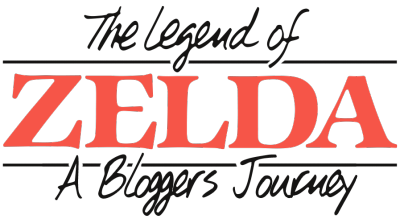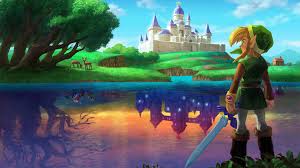
This post is part of a very much larger and very much more collectively awesome series orchestrated by my friend NekoJonez. Do make sure to check out his wonderful NekoJonez’s Gaming Blog, but especially this page, which is the hub article for the overall project: here you’ll get an explanation of what this project is about, and links to articles that a whole load of other talented bloggers have written about every other Zelda game that there is. It’s very cool! Also, credit has to be given to the creator of the logo we’re using in all our posts, so check out their other work here.

Some are going to think this is a wild overstatement, and that’s okay, but I don’t think the universally-acclaimed Breath of the Wild would have been able to happen if it weren’t for A Link Between Worlds.
I’m not saying that Nintendo needed LBW in order to make enough money to afford production of BotW or anything like that, but that LBW was one of the first Zelda games in a while to do something a little bit jazzy with the usual go-to-dungeons-in-this-order-to-get-the-item-for-the-next-dungeon formula. I don’t know if it’s what you’d call an open-world RPG to the same extent that Breath of the Wild would eventually become, but it experimented with the idea that maybe the path Link would take to reach his eventual destination might not be pre-determined, allowing the player to just sort of do things the way they wanted in a hitherto un-Zelda-like manner.
A Link Between Worlds takes place in Hyrule, as per usual. It’s set after Link’s Awakening and the Oracle games, but before the original Legend of Zelda, making it the seventh game in the ‘Hero Defeated’ branch of the timeline, and it’s also kind of a successor to Link to the Past, being in the same version of Hyrule but a long-ass time later and with a bit of world expansion, as it were. See, this game, a little bit like Twilight Princess and probably others I can’t think of off the top of my head, takes place in both Hyrule and a place which is not Hyrule (in TP’s case, the Twilight Realm). In A Link Between Worlds, our friendly neighbourhood Link is… well, between worlds. We’ve got Hyrule, and then we’ve got Lorule (geddit? High, low, it’s sort of a pun? Har-de-har). Lorule is a sort-of-alternate-dimension version of Hyrule; it’s got a princess named Hilda who’s basically an analogue to Zelda, its own version of the Triforce… except, as it turns out, Hilda’s actually using Yuga, an evil sorcerer, to summon Ganon and steal Hyrule’s Triforce to replace Lorule’s darkened and broken one.
So, yeah, this game isn’t going to follow the standard conventions of your regular ol’ Zelda. Obviously Zelda herself was never going to be the antagonist, but in Hilda you’ve got someone who’s pretty much as close to Zelda as you can get, and she turns out to be the main antagonist (albeit a relatively well-intentioned one, I guess, since she just wants to save her kingdom). Link’s Lorulean counterpart is also a different take on what a kingdom’s hero looks like, having abandoned Hilda in cowardice and shame and become a rabbit-costumed merchant by the name of Ravio. He comes good in the end, but most of his role in this game is to provide the means for Link to run around doing the dungeons in whatever order he likes.
Ravio isn’t a normal merchant, in that he’s (I think, but I’m sure someone will correct me if I’m mistaken) the first person in the series to rent his wares out to Link rather than outright selling them. (He does sell stuff, too, but that’s just par for the course.) It’s weird, because he pops over to Hyrule expressly for the purpose of helping Link and Zelda save both realms, then is very graciously allowed to live in Link’s house for free, and yet he still won’t let go of crucial items for anything less than a pretty steep price. Anyway, this is the mechanic that makes A Link Between Worlds much less linear than previous entries, giving Link the ability to get hold of crucial items at any point he likes and therefore tackle the dungeons in any order. Ultimately, he’s still got to do particular sequences before the end-game, and it’s understandable that LBW stops short of being a full-on go-wherever-you-want-whenever-you-want-open-worlder because that was completely new ground for the series at the time. LBW was, though – at least, I think it was – crucial in setting that precedent so that Breath of the Wild would be able to break that new ground.
Another gameplay mechanic unique to A Link Between Worlds is that Link can occasionally slink into walls, becoming a weird little painting-like fellow. It’s key to exploration, and one of the main antagonists uses a similar kind of painting transformation magic in battle. I won’t dwell on ‘Wall Merging’ too much because, although it was a fun little mechanic reminiscent of the Paper Mario games’ blending of 2D and 3D puzzle-solving, it wasn’t exactly a game-changer in the way that Ravio and his semi-open-worlding was.
The parts of the game that follow the usual sort of building blocks may not be revolutionary, but they do manage to do everything really well. That might not sound like a giant compliment, but imagine a Zelda game that didn’t do all the basic things well. (I’m not naming any names, but I think we know what that looks like, and it’s… not the best.) The bosses, for example, may not be anything to write home about, but I don’t think any of them are badly done at all.
I don’t think there’s too much to say about the plot either, besides what we’ve already touched on around the mirror world of Lorule and its rather intriguing inhabitants. With a few nifty little twists, LBW follows a relatively standard Zelda formula: beat bosses, get Master Sword, defeat Ganon. The Seven Sages and the Triforce crop up as plot tokens-cum-collectibles along the way, as you might expect. I’m making it sound as if this game is nothing special in plot terms, but actually I really enjoyed the plot. The little twists it stuck in really made it worthwhile, with enough freshening up of the usual LoZ itinerary to make it all seem new and exciting. I think if there’s anything I can say to sum up A Link Between Worlds’ contribution to the series, that would be it: while this game itself may not have been an absolute groundbreaker, it really did pave the way for the series to go in a new and exciting direction, moving into uncharted waters that would still manage to feel like fitting continuations of the tried and tested elements of the series we all know and love.
There you go, then: that’s A Link Between Worlds! Don’t forget to check out Jonez’s hub article, with all its links (heh) to the posts that all the other talented bloggers have created about every other Zelda game that there is!
[…] OverThinkerY takes us between worlds. Is the Link there? […]
LikeLike
This game’s mechanic was so much fun. I tried merging into walls on so many spots.
I thought that this game was too easy in certain spots. But overall, I had a great time with this game. Even when I saw the ending of this game coming from a mile away.
Just reading this article makes me want to replay this game.
Also, I’m glad that Nintendo took the pin concept of this game to Breath of the Wild. I wouldn’t be able to finish Breath of the Wild without that.
LikeLiked by 1 person
Well, one game that beat “A Link Between Worlds” to the punch in terms of renting items to the player was “Zelda: Ancient Stone Tablets” (one of the obscure BSX broadcast titles), where I know you could rent both a stronger sword and also a shovel (which I found odd). The shovel was needed to find heart pieces and such, but the sword upgrade was more of just giving you a temporary boost in power.
I really did enjoy ALBW and I agree with you that this one’s most impressive addition to the series was its non-linear design. I liked being able to rent/buy items and take off in whatever direction I wanted, yet I knew that there was still an over-arching story pulling things together in the end. I do recall some dungeons did have upgrades or items you could not purchase, though, and I found that this did, in a couple cases, make it slightly less linear, but that was okay: the game was experimenting with something new.
As to games that don’t get the basics done right, well…Zelda II is one people typically cite for this, though as I mention in my own piece on that game, I think it deserves a bit of credit and a second look 🙂
LikeLike
[…] there is gets a post written about it! This was really fun to be a part of, and I got to contribute three posts – I learned a lot about the games I was writing about, and through reading everyone […]
LikeLike
[…] the auspicious debut of the new and improved Musical Mayhem is NekoJonez, he who put together the Zelda Project and appears in the 999 playthrough! He’s one of the people I’ve met through […]
LikeLike
[…] project in a similar vein to NekoJonez’ Zelda Project is currently in the works, co-orchestrated by myself and the Well-Red Mage – expect more […]
LikeLike